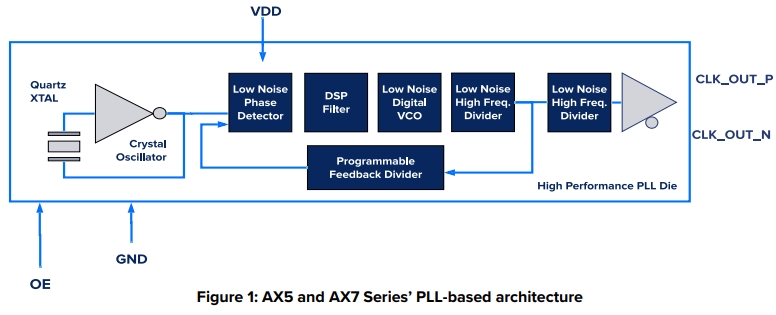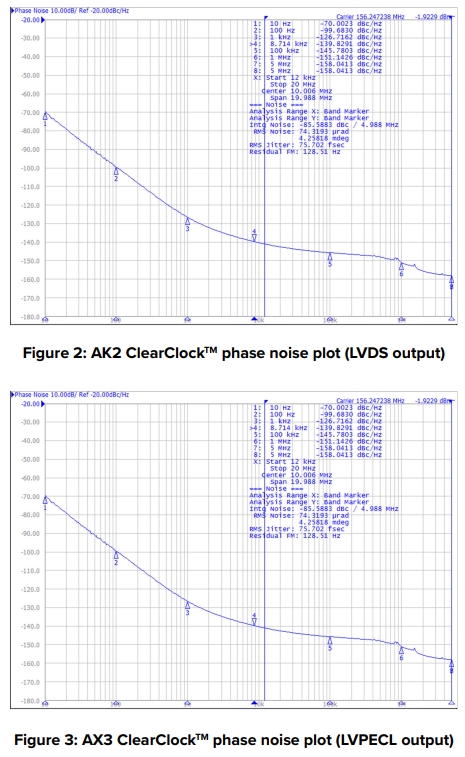彼得曼32.768K有源晶振的优势,Time requirements in modern metering applications have massively increased in the last few years. The usual requirement in modern metering applications is a time offset of 1 hour after 7 years. It should also be possible for the operating temperature range of the application to comply with this value. 1 hour max. after 7 years corresponds to a frequency tolerance of ±16 ppm absolute at 32,768 kHz. It is no longer possible for conventional 32,768 kHz oscillating crystals to meet these requirements.
On the one hand, this is because 32,768 kHz are only available with a frequency tolerance of ±10ppm at +25°C, on the other hand, the temperature stability over a temperature range of -40/+85°C is more then -180 ppm. Moreover, ageing of approx. ±30 ppm after 10 years must be taken into account when calculating accuracy. In the worst case, a 32,768 kHz crystal has a maximum frequency stability of +40/-220 ppm (including adjustment at +25°C, temperature stability and ageing after 10 years). External circuit capacitance must be able to compensate any systematic frequency offset caused by the internal capacitance of the oscillator stage of the IC to be synchronised and by stray capacitance. The selection of a layout without external circuit capacitance for the 32,768 crystal involves a great risk because the accuracy of the 32,768 crystal can neither be corrected nor adjusted to suddenly changing PCB conditions during series production. Initially, the intersection angle for the 32,768 crystal was designed for optimal accuracy in wristwatches, and not for most of the applications for which it is used nowadays.
In order to meet the highly accurate time requirements, we as a clocking specialist offer the series ULPPO ultra low power 32,768 kHz oscillator. This oscillator can be operated with each voltage within a VDD range of 1.5 to 3.63 VDC. The specified current consumption is 0.99 µA. The temperature stability of ULPPOs is ±5 ppm over a temperature range of -40/+85°C. Frequency stability (delivery accuracy plus temperature stability) is ±10 ppm, and ageing after 20 years is ±2 ppm. Thus the maximum overall stability of ULPPOs is ±12 ppm including the ageing after 10 years. These are industry best parameters.
No external circuit capacitance is required for the circuiting of the ultra small housing (housing area: 1.2 mm2). The input stage of the IC installed in the ULPPO independently filters the supply voltage. Compared to crystals, ULPPOs save a lot of space on the printed circuit board so that the packing density can be increased, and smaller printed circuit boards can be designed. The adjustment of the amplitude further reduces the power consumption of the ULPPO.
For space calculations, both external circuit capacitances for a crystal on the printed circuit board must also be taken into account. With its two external circuit capacitances, even the smallest 32,768 kHz crystal requires more space on the PCB than ULPPOs do.
Moreover, very small 32,768 kHz crystals have very high resistances which usually cannot be safely overcome by the oscillator stages to be synchronised because the oscillator stages of the ICs or RTCs to be synchronised have very high tolerances as well. Therefore, sudden response time problems in the field might occur which can be ruled out with ULPPOs. Thus, the safe operation of the application is possible with ULPPOs under all circumstances.
Oscillator stages consume a lot of energy to keep a 32,768 crystal oscillating. Usually, the input stage of the MCU can be directly circuited with the LVCMOS signal of the ULPPO (usually Xin). Thus the input stage of the MCU can be deactivated (bypass function) so that the energy saved can be used for the calculation of the system power consumption of the meter. Moreover, ULPPOs are able to synchronise several ICs at a time. Due to the very high accuracy of the ULPPO, less time synchronisations are required, which also saves system power.
Of course, ULPPOs can be used in any applications which require miniaturised ultra low power 32,768 kHz oscillators such as smartphones, tablets, GPS, fitness watches, health and wellness applications, wireless keyboards, timing systems, timing applications, wearables, IoT, home automation, etc. Due to the high degree of accuracy of 32,768 kHz oscillators, the standby time or even the hypernation time in hypernation technology applications can be significantly increased so that a high amount of system power can be saved due to the significantly lower battery-intensive synchronisation cycles. Thus the 32,768 kHz oscillator is the better choice compared to 32,768 kHz crystals. Ultra low power 32,768 kHz oscillators are available with diverse accuracy variations – see also the ULPO-RB1 and -RB2 series.
不断精进自我的优质制造商彼得曼公司,致力于开发大量高质量的产品,随着近几年来,现代计量应用的时间要求大幅提高。现代计量应用的通常要求是7年后时间偏移1小时。应用的工作温度范围也应符合该值。最多1小时。7年后对应于32,768kHz下16ppm绝对值的频率容差。传统的32,768 kHz振荡晶体不再可能满足这些要求。彼得曼32.768K有源晶振的优势.
一方面,这是因为32,768kHz仅在+25°C时具有10ppm的频率容差,另一方面,在-40/+85°C温度范围内的温度稳定性高于-180ppm。此外,老化约。计算精度时,必须考虑10年后的30ppm。最差情况下,32.768K有源晶振的最大频率稳定性为+40/-220 ppm(包括+25°C时的调整、温度稳定性和10年后的老化)。外部电路电容必须能够补偿由要同步的ic振荡器级的内部电容和杂散电容引起的任何系统频率偏移。为32,768晶振选择无外部电路电容的布局包含很大的风险,因为在批量生产期间,32,768晶振的精度既不能校正也不能调整以适应突然变化的PCB条件。最初,32,768英寸晶体的交叉角度是为手表的最佳精度而设计的,而不是为如今使用它的大多数应用而设计的。
Rakon发布适用于低轨卫星星座的小型GNSS接收器
Rakon瑞康晶振公司自豪地推出其新的GNSS接收器数据库(子板),这是其用于新空间任务的下一代设备套件中的第一款产品。GNSS接收机DB是一种低功耗的紧凑型现成GNSS接收机,专门为小型和超小型卫星设计。凭借多频段和多星座支持,该设备可以同时处理多达448个通道的信号,以提供高性能的位置、速度和时序。
Rakon面向5G应用的XMEMS晶体技术
Rakon瑞康晶振的新型石英MEMS技术XMEMS®基于NanoQuartz™. 一种专有的晶圆级光刻工艺,可显著减少零件间的差异,从而获得更一致的质量。该技术还可以制造非正统的谐振器结构,从而提高老化性能。纳米石英™ 允许对基本谐振器特性进行更严格的容差控制,例如高Q、更好的频率稳定性和抑制不想要的模式。石英贴片晶振的自然特性产生了高质量因数(Q),当与最先进的处理技术相结合时,可提供前所未有的振荡器性能。
为什么XMEMS®石英晶体振荡器使用经过验证的石英技术,该技术已由大型供应商生态系统改进了几十年,并在全球数十亿的现场部署中使用。
Rakon瑞康5G同步解决方案
超低相位噪声VCXO
5G频谱频率范围从<1到100 GHz。初步试验专注于通常低于6GHz的频率在可用频谱上。这样的频率要求低相位噪声参考时钟以支持基于更高QAM速率的更高数据速率。参考时钟相位噪声应最小化,以减少对误差矢量幅度(EVM)掩码的贡献,从而实现更高的QAM速率,从而增加带宽。传统的压控晶体振荡器(VCXO)用于过滤RF合成器中的近相位噪声,当乘以更高阶时会产生高相位噪声。
Rakon的超低噪声VCXO(100–155 MHz)提供非常低的相位噪声和抖动(在12 kHz–20 MHz带宽上约为15 fs)以及低于-170 dBC/Hz的基底噪声。这些是5G RRU的理想选择,尤其是毫米波应用。
In the world of electronics, crystal oscillators are indispensable components. They're found in everything from consumer electronics to telecommunications equipment, providing the precision timing necessary for these devices to operate correctly. But a question that often arises is: Are crystal oscillators polarized? Let's delve into this, while also discussing what a crystal oscillator does and its main advantages.
A crystal oscillator is an electronic device that uses the mechanical resonance of a physical crystal of piezoelectric material to create an electrical signal with a very precise frequency. This frequency is used to keep track of time, as in quartz wristwatches, to provide a stable clock signal for digital integrated circuits, and to stabilize frequencies for radio transmitters and receivers.
The crystal, usually quartz, oscillates or vibrates at a specific frequency when voltage is applied. This vibration is then converted back into a voltage at the same frequency, creating an incredibly stable and consistent signal that can be used for timing purposes.
Polarity refers to the electrical property of having two oppositely charged poles - one positive and one negative. Components that are polarized must be connected in a certain way to function properly. However, crystal oscillators are not polarized. They can be connected in any orientation and will still function as expected.
The reason for this lies in how crystal oscillators work. The piezoelectric crystal within the oscillator vibrates when voltage is applied, regardless of the direction of that voltage. As such, there's no 'right' or 'wrong' way to connect a crystal oscillator – it will function correctly as long as it's properly connected to the circuit.
Crystal oscillators offer several key advantages that make them widely used across various applications:
1. High Stability: Crystal oscillators generate signals with excellent frequency stability and precision, making them ideal for tasks that require accurate timing.
2. Wide Frequency Range: These oscillators can generate signals over a wide range of frequencies, providing flexibility for different applications.
3. Low Power Consumption: Due to their design, crystal oscillators consume relatively low power, which is beneficial for battery-operated devices.
4. Durability: Crystal oscillators are highly durable and resistant to environmental changes such as temperature and humidity fluctuations.遥遥领先加高晶体振荡器极化有何影响?
In conclusion, while crystal oscillators are not polarized, their role in providing precise and stable timing signals is crucial in the realm of electronics. With their high stability, wide frequency range, low power consumption, and durability, it's no surprise that crystal oscillators are a cornerstone of modern electronic devices.
晶体振荡器是极化的吗?
在电子领域,石英晶体振荡器是不可或缺的元件。从消费电子产品到电信设备,它们无处不在,为这些设备的正确运行提供必要的精确计时。但是经常出现的一个问题是:晶体振荡器是极化的吗?让我们深入研究这一点,同时讨论晶体振荡器的作用及其主要优势。
领先同行高加音频晶体打开沉浸感的新维度,Unleashing the Power of Audio Crystals: Elevating Your Sound Experience
Introduction
In the realm of audio technology, a fascinating innovation has emerged - audio crystals. These remarkable crystals have revolutionized the way we perceive and experience sound. In this blog post, we will explore the enchanting world of audio crystals, delving into their capabilities, benefits, and how they have transformed our audio landscape.
Understanding Audio Crystals
Audio crystals are specialized components that possess unique properties for enhancing sound quality. These crystals are meticulously engineered to resonate at specific frequencies, allowing them to optimize audio performance across various devices and settings. By harnessing the inherent properties of these crystals, audio engineers can unlock the full potential of sound reproduction.
The Science Behind Audio Crystals
Audio crystals operate on the principle of piezoelectricity. This phenomenon occurs when certain crystals generate an electric charge under mechanical stress, such as when subjected to vibrations or pressure. By strategically incorporating these crystals into audio systems, the vibrations caused by sound waves can be efficiently converted into electrical signals, resulting in clearer, more immersive sound reproduction.
Benefits of Audio Crystals
The integration of audio crystals brings about several noteworthy benefits:
The Future of Audio Crystals
As technology continues to advance, the potential of audio crystals is boundless. With ongoing research and development, we can expect even further advancements in sound reproduction, leading to more refined audio experiences for enthusiasts and professionals alike. The integration of audio crystals into emerging technologies, such as virtual reality and augmented reality, holds exciting possibilities for immersive audio in the future.
In conclusion, audio crystals have emerged as a game-changing innovation in the world of audio technology. By harnessing their unique properties, we can unlock new dimensions of sound quality and immersion. As we continue to explore the endless possibilities of audio crystals, one thing is certain - the future of sound has never sounded brighter.
释放音频晶体的力量:提升您的声音体验
介绍
在音频技术领域,一项引人入胜的创新出现了——音频晶体。这些非凡的晶体彻底改变了我们感知和体验声音的方式。在这篇博文中,我们将探索音频晶体的迷人世界,深入了解它们的功能、优势,以及它们如何改变了我们的音频格局。
了解音频晶体
音频晶体是一种特殊的部件,具有增强音质的独特性能。这些压电石英晶体经过精心设计,可在特定频率下共振,从而优化各种设备和设置的音频性能。通过利用这些晶体的固有特性,音频工程师可以释放声音再现的全部潜力。
音频晶体背后的科学
音频晶体根据压电原理工作。当某些晶体在机械应力下产生电荷时,例如受到振动或压力时,就会出现这种现象。通过战略性地将这些晶体融入音频系统,声波引起的振动可以有效地转换为电信号,从而实现更清晰、更身临其境的声音再现。
Abracon ClearClockTM晶体振荡器系列解决方案,由于不断增加的时钟抖动,系统设计者面临着与参考时钟抖动相关的基本挑战需要更小的形状因子:随着参考振荡器内石英晶体的尺寸减小,保持优异rms抖动性能的能力变得具有挑战性。随着不断的需求无论是系统的整体尺寸还是功能,设计者都在寻找满足最佳要求的参考时钟小尺寸收敛和抖动性能。
从一开始,Abracon就专注于始终如一地实现这种融合以微型形状因子生产超低均方根抖动时钟解决方案。2018年,Abracon推出了两款ClearClockTM系列下的解决方案,5x3.2mm和5x7mm封装的AX5和AX7系列有源晶体振荡器,分别地这些设备基于复杂的PLL技术,如图1所示卓越的均方根抖动性能–通常在载波12kHz至20MHz范围内优于150fs。

在上述PLL方法中,采用了一些技术来提高相位噪声的限制检测器底板,使相位噪声斜率提高了收敛性——进一步远离载波。AX5和AX7设备经过优化,可满足50MHz和2.1GHz载波之间的市场需求频率。这些设备可以配置为之前指定的Abracon的生产设施。凭借提供业界领先的频率上限的能力,AX5和AX7解决方案非常适合需要大于200MHz时钟的应用参考.
Abracon进一步认识到,对需要100至200MHz时钟的客户的需求日益增长与基于PLL的AX5和AX7设备相比,具有更小形状因数的解决方案。这些要求是通常以PCI Express(PCIe)、光收发器、数据存储和网络设计为中心。
作为回应,Abracon推出了第三泛音ClearClockTM OSC振荡器解决方案:AK2、AX3、AK5和AK7系列这些设备使用更安静的架构,实现卓越的超低均方根抖动性能和业界领先的微型封装能效.
例如,2.5x2.0x1.0mm AK2 ClearClockTM提供尽可能低的外形典型的均方根抖动性能为117fs@156.25MHz,LVDS输出格式为+2.5V偏置在远离载波的12kHz到20MHz带宽上,最大保证抖动性能为200fs。(见图2。)

AX3 ClearClockTM有源晶振采用3.2 x 2.5 x 1.0 mm封装,可提供低于80fs的典型均方根抖动在156.25MHz载波上,LVPECL输出格式的+3.3V偏置。(参见上一页的图3。)
第三泛音设备性能的秘诀在于其架构的简单性。精心设计第三泛音晶体空白,连同所需载波信号的适当捕获,确保在感兴趣的载波上具有出色的均方根抖动性能。
Abracon offers in-system tuning services for patch and chip antennas. This takes the guess work out of RF verification while offering corrective measures. It can maximize system efficiency with benefits such as, extended RF range, improved sensitivity and reduced power consumption of a transmit range.
Abracon晶振为贴片天线和芯片天线提供系统内调谐服务。这在提供纠正措施的同时,减少了射频验证的猜测工作。它可以最大限度地提高系统效率,具有扩展射频范围、提高灵敏度和降低发射范围功耗等优点。超越未来解决方案的性能、尺寸、功率和可靠性要求的晶体、振荡器和谐振器产品。
ASAKMP是一款连续伏特32.768k晶振,小体积尺寸1.6x1.2mm振荡器,在-40℃至85℃温度范围内具有±10ppm的稳定性,电源电压选择范围为1.8V至3.3V,电源电流 < 27uA。
Abracon晶振ABS05系列编码ABS05-32.768kHz-12.5pF3T,超小型1610mm晶振,无源晶振
与传统的tcxo相比,RTH7050PA的关键亮点是其对温度的低频灵敏度和优良的相位噪音。频率随温度变化的斜率低至0.5 ppb/°C。创新的Rakon设计使用了高q石英无源晶体它的核心,从而导致优越的相关噪声性能。它还保证振荡器的所有原因的稳定性≤4.6 ppm/20年。随着工作温度范围的扩大,这些频率规格使远程无线电头(RRH)锁相环使用单一参考时钟,以满足网络同步要求和空中接口要求。
CFPT9300是一系列表面可安装的5.0 x 3.2 mm压控温补晶体振荡器(TCVCXOs)中小型和高性能是先决条件的中到高容量应用程序。它使用了Rakon公司专有的ASIC‘Pluto™,a单片机振荡器和模拟补偿电路,能够在扩展的温度范围内的±0.2 PPM性能。它的功能下降到2.4 V的供电电压和低功耗使其特别适合移动应用。
Rakon 最新的里程碑式创新 XMEMS ®将石英的卓越固有稳定性与 NanoQuartz™ 光刻工艺相结合。结果是一系列非常可靠的微型石英晶体谐振器和振荡器,在温度范围内具有一流的频率、长期稳定性和相位噪声。
Rakon拥有广泛的温度补偿晶体振荡器 (TCXO) 解决方案。 可用产品包括 适用于 苛刻环境的 高性能、 超稳定 TCXO ,以及适用于大批量消费应用的高稳定性TCXO温补晶体振荡器。Rakon 对质量和高性能的承诺意味着它已成为电信基础设施、紧急 定位 信标、GNSS、军事和其他性能关键 应用的默认标准.
瑞康晶振公司生产的高稳定性TCXO在 -40 至 85°C 范围内提供 ±0.5 ppm 的频率稳定性。对于汽车和定位等特定应用,工作温度范围可从 -40°C 扩展到 105°C。
可用的封装尺寸范围从 3.2 x 2.5 mm、2.5 x 2.0 mm 到 2.0 x 1.6 mm。
ROM9070PA采用Rakon市场领先的专有水银+™技术,提供世界上最小和最低功率的OCXO无线应用程序。该产品系列在‐40 - 95°C范围内达到±10 ppb频率稳定性,短期老化小于1 ppb/天频率斜率低至0.1 ppb/°C。低灵敏度和扩展工作温度可根据要求提供。使用Rakon创新的高Q石英无源晶体,ROM9070PA提供优越的近相位噪声性能,使远程无线电头锁相环成为可能使用一个参考时钟来满足网络同步要求和空中接口要求。
Rakon在其超稳定OCXO产品组合中不断发布新的一流产品,并开创了新的晶体和传感器技术,凭借着独特的创新精神,高超的生产技术,以成为业界传奇一般存在的领导者,引领着石英晶体振荡器的发展趋势,并获得广大用户忠诚与信赖,成就如今杰出的Rakon晶振公司.
ROD2522S2 是在通用 25 x 22 mm 封装上开发的,可与当前的 ROX2522 互换。主要好处是,使用 ROX2522 的现有系统现在可以随时轻松升级,以获得卓越的保持和频率稳定性性能,而无需额外投资重新设计设备。
在这十年中,Rakon 将 TCXO 技术提升到了一个新的水平,为电信、国防和定位市场推出了两个超稳定的TCXO晶振平台。专有和专利 Pluto ®的开发ASIC 技术在 2007 年很快引领行业并占领了紧急定位信标等新市场.
RHT1490 也可用于无线应用;低近端相位噪声性能(<-120 dBc/Hz @ 1 kHz 偏移,122.88 MHz 时钟)使其成为 C-RAN 无线电头端、微波链路和小型蜂窝应用的理想选择。
RHT1490 在近端相位噪声和本底噪声之间实现了最佳平衡,使其适合作为用于网络和空中接口应用的单一参考时钟。其出色的隔热性和抗气流性,使系统设计具有高度的灵活性。